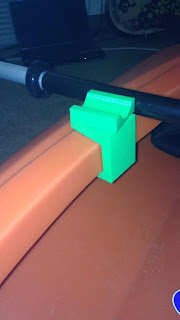 If you want an example of how tech and manufacturing are changing before our eyes, you don't have to look very far.
If you want an example of how tech and manufacturing are changing before our eyes, you don't have to look very far.
Recently my daughter wanted a holder for her kayak paddle to keep it from rolling around the top. It's nice to have if you're fishing or want to take your hands off of the paddle to take a picture .
She happens to be a mechanical engineering student, so naturally she was going to make something. When I was her age I would have probably made something out of a crushed beer can and duct tape. You can scratch the probably because I likely did that for the boat I had when I was in school. And never mind the age, that's probably the solution I'd arrive at today.
When I was her age I would have probably made something out of a crushed beer can and duct tape. You can scratch the probably because I likely did that for the boat I had when I was in school. And never mind the age, that's probably the solution I'd arrive at today.
Nope. Not her, not now. They have access to 3D printers at school. 3D printing, if you're not familiar is the process that's very similar to regular ink printing on paper. Instead of ink the machine drops a plastic resin that solidifies into hard plastic. Instead of one pass over a sheet of paper, the 3D printer can make multiple passes to build up the piece into the final design.
She designed a snap-on piece that swivels to accommodate the angle of the paddle no matter where it's placed on the cockpit of the boat. It's two pieces but made in one printing. Nice. Certainly better than a beer can.










